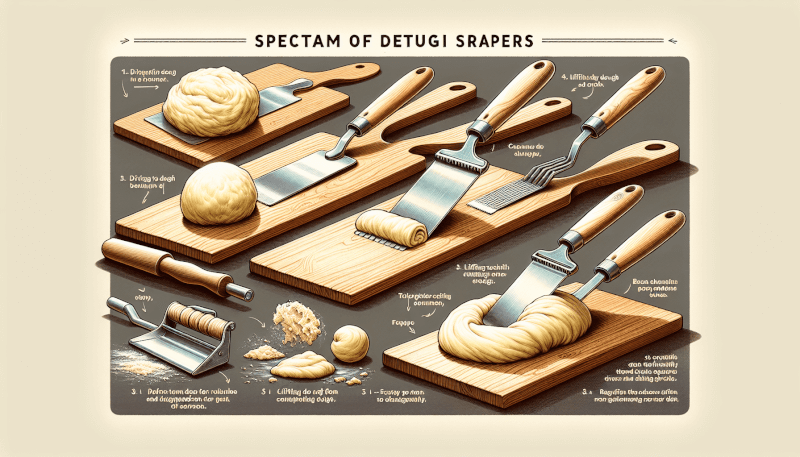Have you ever found yourself struggling to clean up sticky dough from your countertops? Or perhaps you’re tired of wasting precious flour while trying to scrape every last bit of dough off your cutting board. Look no further, because in this article, you will learn all about the proper usage of a dough scraper. From its various functions to the best techniques for a seamless dough scraping experience, we’ve got you covered. Say goodbye to messy countertops and hello to a more efficient baking process.

Choosing the Right Dough Scraper
When it comes to choosing the right dough scraper, there are a few factors to consider. Firstly, you should take into account the material of the scraper. Common options include stainless steel, plastic, or silicone. Stainless steel scrapers are durable and easy to clean, while plastic scrapers are more affordable and flexible. Silicone scrapers, on the other hand, are heat-resistant and gentle on delicate surfaces. Choose the material that best suits your needs and preferences.
Secondly, it is important to choose the right size of dough scraper. The size you choose will depend on the amount of dough you usually work with. If you often bake in large quantities, opting for a larger scraper would be more efficient. However, if you usually work with smaller amounts of dough, a smaller scraper would be more suitable. Consider your personal baking habits and select the size that will make your dough preparation process easier.
Lastly, you should look for a dough scraper with a comfortable grip. Since you’ll be using the scraper for an extended period of time, it’s important to choose one that feels comfortable in your hand. Look for a handle that provides a good grip and feels ergonomic. This will prevent any discomfort or strain on your hand during use.
Preparing the Dough
Before you can use a dough scraper, you need to properly prepare the dough. This process involves two main steps: mixing the ingredients and kneading the dough.
To mix the ingredients, start by measuring out the required amounts of flour, water, yeast, and any other ingredients specified in your recipe. Use a large mixing bowl and a whisk or a spoon to thoroughly combine the ingredients until they form a rough dough. Make sure there are no pockets of dry flour remaining.
Next, it’s time to knead the dough. This step helps develop the gluten in the dough, which gives it structure and elasticity. Begin by lightly flouring a clean surface, such as a countertop or a large cutting board. Transfer the dough onto the floured surface and use your hands to push and fold the dough repeatedly. This process should be done for about 10-15 minutes or until the dough becomes smooth and elastic.
Using the Dough Scraper
Once your dough is properly prepared, it’s time to make use of your dough scraper. There are three main ways you can use a dough scraper: dividing the dough, transferring the dough, and scraping the work surface.
Dividing the dough is particularly useful when you have a large batch of dough that needs to be separated into smaller portions. To do this, use your dough scraper to cut the dough into equal pieces. Simply press down firmly with the scraper and use a sawing motion to cut through the dough. The sharp edge of the scraper will make this task quick and precise.
Transferring the dough from one surface to another can be tricky without a dough scraper. However, with the scraper, it becomes much easier. Simply slide the scraper under the edge of the dough and lift it up. You can then transfer the dough to a baking sheet, a proofing basket, or any other surface you need it on.
Another important use of a dough scraper is to scrape the work surface clean. After kneading or rolling out the dough, there may be bits of dough or flour stuck to the surface. Use the dough scraper to gently scrape away these remnants, ensuring a clean work surface for the next steps in your baking process.
Cleaning and Maintaining the Dough Scraper
Properly cleaning and maintaining your dough scraper is essential for its longevity and continued effectiveness. There are three key steps to follow: cleaning after use, drying properly, and storing the scraper.
After using the dough scraper, it’s important to clean it thoroughly. Rinse off any dough or food particles under running water and use a sponge or brush to scrub away any stubborn residue. Pay special attention to any crevices or edges where dough may get stuck. Make sure to use a mild dish soap to avoid damaging the scraper.
Once your scraper is clean, it’s crucial to dry it properly. Wipe it down with a clean towel or paper towel to remove any excess moisture. If the scraper is made of stainless steel, plastic, or silicone, you can also leave it to air dry. However, if your scraper has a wooden handle, it’s best to hand dry it to prevent any warping or damage.
Lastly, store your dough scraper in a safe and easily accessible location. Consider hanging it on a hook, placing it in a utensil drawer, or keeping it in a designated baking tool container. By storing your scraper properly, you’ll be able to find it easily when needed and keep it in good condition.

Alternative Uses for a Dough Scraper
While a dough scraper is primarily used for dough-related tasks, it can also be utilized in other areas of the kitchen. Here are a couple of alternative uses for a dough scraper:
Chopping and Scooping: A dough scraper can be a handy tool for chopping ingredients, such as herbs or vegetables. Its flat edge allows you to gather and scoop the chopped pieces easily. This can be especially useful when preparing salads or stir-fries.
Measuring Ingredients: In addition to its primary use, a dough scraper can also be used to measure ingredients. The straight edge of the scraper can serve as a convenient guide for leveling off dry ingredients, such as flour or sugar, when measuring with a measuring cup or spoon.
Common Mistakes to Avoid
To ensure you make the most of your dough scraper, it’s important to be aware of common mistakes and avoid them. Here are two common mistakes to watch out for:
Using Excessive Force: While a dough scraper is a sturdy tool, it’s important not to apply excessive force when using it. Overly aggressive scraping or cutting motions can damage your work surface or even cause injury. Instead, use controlled and gentle motions to avoid any mishaps.
Not Cleaning Properly: Neglecting to clean your dough scraper properly after each use can lead to the buildup of dried dough or food particles, which can be difficult to remove later on. Taking the time to rinse and scrub your scraper thoroughly after each use will prevent any residue from hardening and ensure its longevity.

Troubleshooting Tips
Even with a good dough scraper, you may encounter a couple of common issues while working with dough. Here are two troubleshooting tips to help you overcome these difficulties:
Difficulties in Scraping: If you find your dough scraper is having trouble scraping residue off your work surface, try lightly flouring the scraper. The flour will act as a barrier between the scraper and the sticky dough, making the scraping process easier.
Sticky Dough: Sometimes, dough can become too sticky and difficult to handle. If you’re struggling with sticky dough, try wetting your dough scraper slightly. The moisture on the scraper will help prevent the dough from sticking to it, allowing you to work with the dough more easily.
Benefits of Using a Dough Scraper
Using a dough scraper offers several benefits that can enhance your baking experience. Here are two key advantages to using a dough scraper:
Efficiently Gather Dough: A dough scraper allows you to easily gather all the dough from your work surface, ensuring that no dough goes to waste. Its flat edge allows you to collect even the smallest scraps of dough, maximizing your dough yield.
Reduce Sticky Hands: Working with dough can often result in sticky hands that require constant washing. However, with a dough scraper, you can minimize the amount of direct contact you have with the dough. This not only keeps your hands cleaner but also prevents excessive moisture from affecting the dough’s texture.

Different Types of Dough Scrapers
There are several types of dough scrapers available, each designed for different purposes. Here are three common types of dough scrapers:
Bench Scraper: Also known as a pastry scraper or a dough cutter, a bench scraper typically has a larger rectangular blade with a handle. This type of scraper is versatile and can be used for various tasks, including dividing dough, transferring dough, and cleaning work surfaces.
Bowl Scraper: Bowl scrapers are curved in shape to fit the contours of a mixing bowl. They are primarily used for scraping the sides of bowls or jars to ensure no ingredients are wasted. These scrapers are often made of flexible materials, such as plastic or silicone.
Plastic vs Metal Scrapers: Plastic scrapers are generally more flexible and gentle on delicate surfaces, making them ideal for working with softer dough or scraping non-stick pans. Metal scrapers, especially those made of stainless steel, are more durable and suitable for heavy-duty tasks like cutting through large batches of dough.
Additional Tools for a Well-Equipped Kitchen
In addition to a dough scraper, there are a few other tools that can greatly enhance your baking experience. Here are three additional tools for a well-equipped kitchen:
Pastry Blender: A pastry blender is a handy tool used for cutting butter or shortening into flour for pastry dough. Its multiple blades or wires cut through the fat, creating a crumbly texture that leads to a flaky crust.
Dough Whisk: A dough whisk, also known as a Danish whisk or a bread whisk, is specifically designed for mixing dough. Its unique shape and sturdy construction allow for efficient mixing without the dough getting stuck in the whisk.
Rolling Pin: A rolling pin is a staple tool for rolling out dough. Whether you’re making pie crusts, cookies, or bread dough, a rolling pin helps you achieve an even thickness and shape. Look for a rolling pin with comfortable handles and a smooth surface for easy rolling.
By incorporating these additional tools into your kitchen, you’ll have everything you need to tackle a wide variety of baking projects with ease.
In conclusion, a dough scraper is a versatile and essential tool for any home baker. By choosing the right material and size, considering the grip comfort, properly preparing the dough, using the scraper correctly, and maintaining it well, you can make the most of your dough scraper. Additionally, knowing the alternative uses, avoiding common mistakes, troubleshooting common issues, and understanding the benefits of using a dough scraper will further enhance your baking experience. Remember to explore different types of dough scrapers and consider other helpful tools to equip your kitchen for successful baking adventures.



